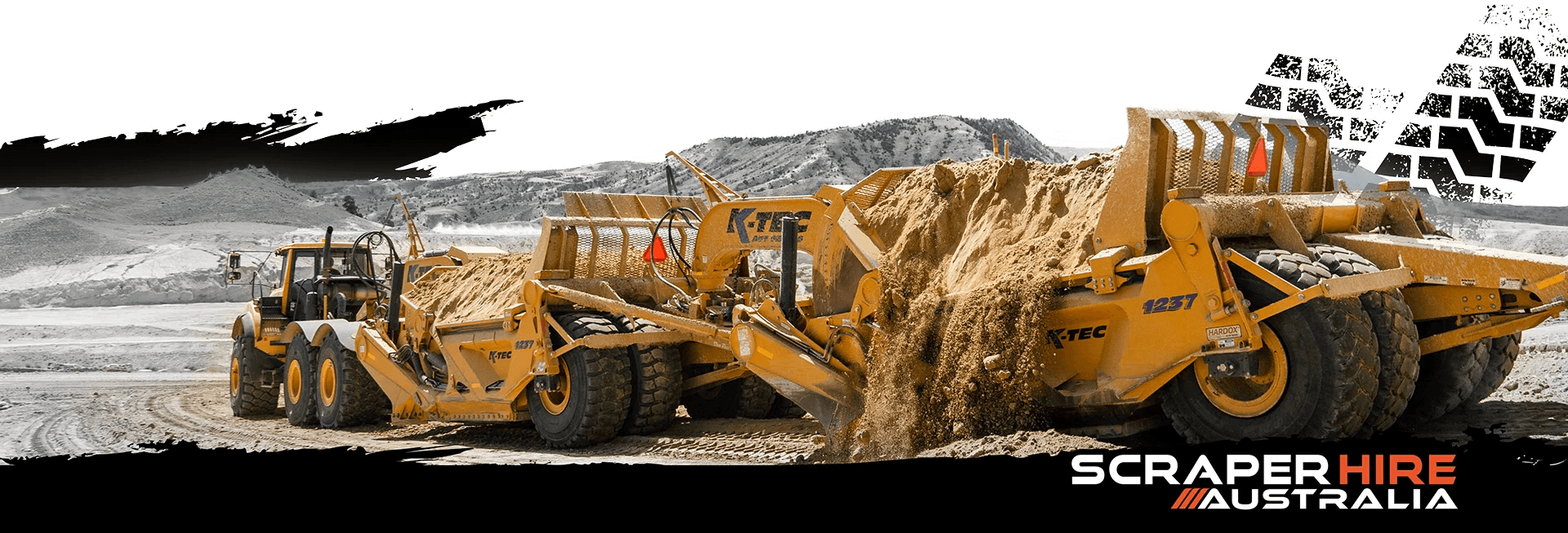Earthmoving projects are the backbone of modern construction, mining, and various other industries. From leveling the ground for infrastructure development to excavating sites for mining operations, the efficiency and capacity of earthmoving equipment play a pivotal role. Among these heavy-duty machines, scrapers have emerged as essential tools for moving large volumes of soil, aggregates, and other materials efficiently. In this article, we’ll delve into the question that often arises in the minds of project planners and site managers: How much dirt can a scraper move in a day?
Factors Affecting Scraper Dirt-moving Capacity
Scrapers come in different types, each designed to tackle specific tasks. In addition to K-Tec scrapers, Ashland Industries also offers a range of scraper models known for their efficiency and performance. The size and capacity of the scraper, along with its engine power, significantly influence its dirt-moving capacity. Additionally, the terrain and soil conditions of the worksite and the operator’s skill level also come into play. These factors collectively determine how much material a scraper can move within a given timeframe.
K-Tec Scrapers: Efficiency Redefined
K-Tec scrapers, renowned for their cutting-edge engineering, have set new benchmarks in dirt-moving efficiency. Let’s explore some K-Tec scraper models that exemplify this efficiency:
K-Tec 1228 Scraper: With a heaped capacity of approximately 28 cubic yards (21 cubic meters), the K-Tec 1228 scraper is designed for mid-sized earthmoving projects. Its compact yet powerful design allows it to efficiently move significant amounts of material within a single cycle. View Tractor Variant | View Moxy Variant
K-Tec 1233 Scraper: Boasting a heaped capacity of around 33 cubic yards (25 cubic meters), the K-Tec 1233 scraper strikes a balance between size and capacity. It is an ideal choice for projects that require substantial dirt-moving capabilities while maintaining maneuverability. View Tractor Variant
K-Tec 1237 Scraper: This model offers a heaped capacity of about 37 cubic yards (28.28 cubic meters), making it suitable for larger-scale projects. Its efficient hydraulic ejection system ensures that material is expelled with precision, enhancing productivity.
View Moxy Variant
K-Tec 1243 Scraper: With a heaped capacity of approximately 43 cubic yards (32.8 cubic meters), the K-Tec 1243 scraper is a workhorse for heavy-duty earthmoving tasks. Its robust construction and advanced features contribute to remarkable dirt-moving efficiency. View Moxy Variant
Ashland Scraper Models: Precision and Performance
Ashland Industries, known for its high-quality scrapers, also offers models that excel in dirt-moving capacity:
Ashland 3250SS Scraper: This heavy-duty model has a heaped capacity of approximately 3.25 cubic yards (2.5 cubic meters). Well suited for large landscape projects, or assist in cleaning up around construction sites. View Skid Steer Variant
Ashland 950XL2 Scraper: This model is equipped with a heaped capacity of approximately 9.5 cubic yards (7.3 cubic meters). While it may be smaller compared to some K-Tec models, its precision and durability make it suitable for a range of earthmoving projects. View Tractor Variant
Ashland 1410E Scraper: With a heaped capacity of around 14 cubic yards (10.7 cubic meters), the Ashland 1410E scraper combines power and efficiency. Its well-designed structure ensures consistent and reliable performance. View Tractor Variant
Calculating Dirt-moving Capacity
Understanding a scraper’s bowl capacity specifications is crucial for accurately estimating its dirt-moving capacity. However, real-world conditions often impact the actual capacity achieved. Calculating the dirt moved per cycle involves considering factors like fill factor, material density, and cycle time. A simple formula involving these variables can provide a ballpark estimate of the scraper’s performance.The formula to estimate the dirt moved per cycle is as follows:
Dirt Moved = Heaped Capacity × Fill Factor × Material Density
Here’s an example calculation for each model over the span of an hour, assuming a fill factor of 85% and a material density of 1.8 tons/cubic yard:
K-Tec 1228 Scraper: 21 m3 × 0.85 × 1.8 t/m3 = 32.49t
K-Tec 1233 Scraper: 25 m3 × 0.85 × 1.8 t/m3 = 38.03t
K-Tec 1237 Scraper: 28 m3 × 0.85 × 1.8 t/m3 = 42.84t
K-Tec 1243 Scraper: 32.8 m3 × 0.85 × 1.8 t/m3 = 50.18t
Ashland 3250SS Scraper: 2.5 m3 × 0.85 × 1.8 t/m3= 3.82t
Ashland 950XL2 Scraper: 7.3 m3 × 0.85 × 1.8 t/m3 = 11.16t
Ashland 1410E Scraper: 10.7 m3 × 0.85 × 1.8 t/m3 = 16.37t
Real-world Case Studies
Let’s take a closer look at two real-world scenarios where scraper efficiency, including K-Tec and Ashland models, made a significant difference. In an urban construction project, a K-Tec scraper was employed to level an area for a new commercial building, while an Ashland scraper was used for a precision grading task. By selecting the right scraper size and training the operator, the project teams achieved remarkable daily dirt-moving capacity and precision, respectively.
Maximizing Scraper Efficiency
To achieve the highest dirt-moving capacity, several strategies come into play. Regular equipment maintenance ensures the scraper operates at peak performance. Operator training is essential to make the most of the machine’s capabilities and to promote safety. Proper site preparation, including the optimization of haul roads and dumping areas, can eliminate unnecessary delays. Moreover, integrating technology such as GPS and telematics enhances scraper efficiency by providing real-time data for better decision-making.
Scraper Hire Services in Australia: K-Tec and Ashland Models
In Australia, we offer top-tier scraper hire services that include a range of K-Tec and Ashland scraper models. Our fleet comprises various scraper sizes, ensuring that clients can select the perfect model for their requirements. By choosing our services, clients benefit from not only state-of-the-art equipment but also our expertise in optimizing dirt-moving efficiency. We understand that every project is unique, and our team works closely with clients to provide solutions that accelerate their progress.
Conclusion
In the grand orchestra of earthmoving equipment, both K-Tec and Ashland scrapers play powerful tunes. Understanding a scraper’s dirt-moving capacity is essential for successful project planning and execution. Factors like scraper type, size, engine power, and operator skill all contribute to the final symphony of productivity. Through real-world case studies, we’ve seen how the right scraper models, combined with proper strategies, can yield impressive results. As you embark on your next earthmoving venture, consider the insights shared in this article to ensure that your project’s dirt-moving capacity hits all the right notes. If you’re in Australia and seeking superior scraper hire services, offering both K-Tec and Ashland models, we invite you to explore our offerings and experience the difference firsthand.




